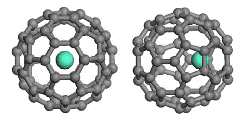Chemistry, Department of: Faculty Series

Xiao Cheng Zeng Publications
Document Type
Article
Date of this Version
5-1-2006
Abstract
We performed a constrained search for the geometries of low-lying neutral germanium clusters GeN in the size range of 21≤N≤29. The basin-hopping global optimization method is employed for the search. The potential-energy surface is computed based on the plane-wave pseudopotential density functional theory. A new series of low-lying clusters is found on the basis of several generic structural motifs identified previously for silicon clusters [S. Yoo and X. C. Zeng, J. Chem. Phys. 124, 054304 (2006)] as well as for smaller-sized germanium clusters [S. Bulusu et al., J. Chem. Phys. 122, 164305 (2005)]. Among the generic motifs examined, we found that two motifs stand out in producing most low-lying clusters, namely, the six/nine motif, a puckered-hexagonal-ring Ge6 unit attached to a tricapped trigonal prism Ge9, and the six/ten motif, a puckered-hexagonal-ring Ge6 unit attached to a bicapped antiprism Ge10. The low-lying clusters obtained are all prolate in shape and their energies are appreciably lower than the near-spherical low-energy clusters. This result is consistent with the ion-mobility measurement in that medium-sized germanium clusters detected are all prolate in shape until the size N~65.


Comments
Published by American Institute of Physics. J. Chem. Physics 124, 184309 2006. ©2006 American Institute of Physics. Permission to use. http://jcp.aip.org/.